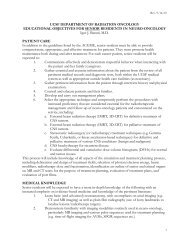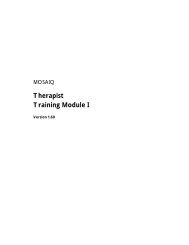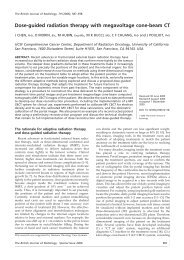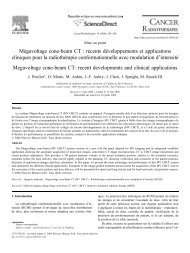Soft Tissue Visualization Using a Highly Efficient Megavoltage Cone ...
Soft Tissue Visualization Using a Highly Efficient Megavoltage Cone ...
Soft Tissue Visualization Using a Highly Efficient Megavoltage Cone ...
You also want an ePaper? Increase the reach of your titles
YUMPU automatically turns print PDFs into web optimized ePapers that Google loves.
<strong>Soft</strong> <strong>Tissue</strong> <strong>Visualization</strong> <strong>Using</strong> a <strong>Highly</strong> <strong>Efficient</strong> <strong>Megavoltage</strong><br />
<strong>Cone</strong> Beam CT Imaging System<br />
Farhad A. Ghelmansarai, Ali Bani-Hashemi, Jean Pouliot*, Ed Calderon, Paco<br />
Hernandez, Matthias Mitschke, Michelle Aubin*, Kara Bucci*<br />
Siemens Medical Solutions Inc., Concord, CA, USA<br />
*Univ. of California at San Francisco, San Francisco, CA<br />
ABSTRACT<br />
Recent developments in two-dimensional x-ray detector technology have made volumetric <strong>Cone</strong> Beam CT<br />
(CBCT) a feasible approach for integration with conventional medical linear accelerators. The requirements<br />
of a robust image guidance system for radiation therapy include the challenging combination of soft tissue<br />
sensitivity with clinically reasonable doses. The low contrast objects may not be perceptible with MV<br />
energies due to the relatively poor signal to noise ratio (SNR) performance.<br />
We have developed an imaging system that is optimized for MV and can acquire <strong>Megavoltage</strong> CBCT<br />
images containing soft tissue contrast using a 6MV x-ray beam. This system is capable of resolving relative<br />
electron density as low as 1% with clinically reasonable doses ranging from 3 to 16 cGy. There are many<br />
factors such as image noise, x-ray scatter, improper calibration and acquisitions that have a profound effect<br />
on the imaging performance of CBCT and in this study attempts were made to optimize these factors in<br />
order to maximize the SNR. A QC-3V phantom was used to determine the contrast to noise ratio (CNR)<br />
and f50 of a single 2-D projection. The computed f50 was 0.43 lp/mm and the CNR for a radiation dose of<br />
0.02cGy was 43. Clinical <strong>Megavoltage</strong> CBCT images acquired with this system demonstrate that<br />
anatomical structures such as the prostate in a relatively large size patient are visible using clinically<br />
acceptable radiation doses.<br />
Key Words: <strong>Megavoltage</strong> cone beam CT, Electronic portal imaging device, <strong>Megavoltage</strong> soft tissue<br />
imaging.<br />
1. Introduction<br />
The goal of the radiotherapy is to deliver the highest possible dose to the tumor while minimizing the dose<br />
to the surrounding tissue. Conformal Intensity modulated radiotherapy (IMRT) and conformal radiotherapy<br />
have been developed to achieve these goals. However, the benefits of these techniques are limited when<br />
large margins have to be used to accommodate uncertainties in target and normal tissue at the time of<br />
treatment. One possible solution is the computed tomography (CT) integrated with the treatment machine.<br />
There are a few approaches available to CT imaging in the treatment position. One such approach<br />
integrates a KV x-ray tube and an a-Si flat panel detector that is mounted on the C-arm gantry of a linear<br />
accelerator. Second approach is to use of the treatment MV beam to obtain CT images either in fan beam or<br />
cone beam scanning geometry.<br />
The use of MV photons to obtain CT images results in a greater absolute dose deposition per photon<br />
compared to KV photons. Therefore, in order to maintain comparable doses for MVCT and KVCT, the<br />
number of MV photons incident on the patient must be considerably reduced and this reduction decreases<br />
the signal to noise ratio. One mitigating factor for MVCT is that the MV photons are more penetrating than<br />
KV photons. Thus, a greater fraction of incident MV photons will travel through the patient and reach the<br />
detector. This effect will provide some compensation for the reduced number of incident photons,<br />
especially for larger patients. Unfortunately, this effect is countered by the increased penetration of the<br />
photons through the detector.
The ability of an x-ray imaging system to differentiate soft tissues is affected by the difference in<br />
attenuation coefficient at a given energy between the contrasting objects. For KV CBCT imaging the<br />
contrast changes with energy, because both the photoelectric and Compton effects contributes significantly<br />
to attenuation. For MV energies the Compton effect is by far the dominant interaction process, especially<br />
for material with low atomic number (Z), in which the attenuation coefficient is proportional to electron<br />
density and is nearly independent of Z. Object contrast is therefore constant over a wide range of energies<br />
in the MV regime. Since the attenuation coefficients of KV photons are higher than MV photons in soft<br />
tissue, the percent density contrasts will be easier to detect at KV energies. Thus, while the higher<br />
attenuation of KV photons results in greater transmission losses, it also benefits KV contrast by the squared<br />
ratio of the mass attenuation coefficient for KV and MV energies 1 .<br />
In this paper we present an implementation of a highly efficient MV CBCT imaging system that can<br />
resolve soft tissue contrast with clinically acceptable doses.<br />
2. Methods and Materials<br />
2.1 Timing Interface for <strong>Cone</strong> Beam Acquisition Mode<br />
The timing interface uses the Radiation-on (Rad-on) signal of linear accelerator (linac) to generate trigger<br />
pulses that externally control the frame readout of flat panel imager. In this mode, a-Si sensors integrate the<br />
signal during the radiation interval of each projection and the data readout is performed at the end of each<br />
projection. The detector is set in the external mode. Five trigger pulses (5 frames scan) are sent to the<br />
external trigger input of the flat panel detector prior to the start of first projection to force sensor discharge<br />
by reading 5 frames in absence of radiation. This eliminates the dark current accumulation prior to the start<br />
of the first projection. No readout is allowed during the projection interval. Avoiding readout during<br />
exposure interval improves the image SNR by reducing the effect of the electronic readout noise, and also<br />
removes the linac pulsing artifacts from the image.<br />
Rad-on<br />
Trigger<br />
2.2 Image Receptor<br />
5 Refresh Pulses<br />
First<br />
Projection<br />
Projection period<br />
Second<br />
Projection<br />
Figure-1: Timing Interface for <strong>Cone</strong> Beam Mode<br />
Third<br />
Projection<br />
Data Projection 1 Data Projection 2 Data Projection 3
Two image receptors that were used for this study contained two components; a metal build up<br />
plate/phosphor screen and a flat panel imager. The flat panel imager had an active area of 41 x 41 cm 2 , and<br />
contained 1024 x1024 elements of 0.4 mm pitch. The fastest frame rate was 7 frames per second and the<br />
output data was 16-bit. Flat panel detectors generate frames either using “Free Running” or “External<br />
Triggered”. Free running means that the detector sends out continuous frames according to the selected<br />
frame time. External triggered means that there is an external trigger which allows the generation of the<br />
maskable interrupt request.<br />
The phosphor screen of one receptor (receptor 1) was a 133 mg/cm 2 Gd 2O 2S screen (Lanex Fast) and for<br />
the receptor 2 was an 800 µm CsI (TI) scintillator screen. Both receptors were using a 1mm copper buildup<br />
plate. The charge amplifier capacitance of receptors 1 and 2 were 5pF and 1pF, respectively.<br />
2.3 <strong>Cone</strong> Beam Image Acquisitions and Corrections<br />
<strong>Cone</strong> beam CT starts by acquiring a large number of projection images acquired as the X-ray source<br />
follows an orbital path. At every angular increment, i.e., every degree, an image is acquired. 201<br />
projections were acquired over 201 degrees (1° rotation between projections) around the subject. The<br />
gantry speed was set to 109° per minute.<br />
The Siemens PRIMUS® linear accelerator parameters were adjusted to allow the delivery of a small<br />
fraction of a Monitor Unit (MU) per image. A very precise dose control was achieved by loading the<br />
accelerator by very small amount of electrons per pulse. In the current design, the injection is phased with<br />
the RF power at startup or during re-phasing of the injector at the programmed angular increment. With<br />
normal beam parameters, the phasing or re-phasing of the injection generates a shift in the resonant<br />
frequency of the accelerator. Because of the lag of the automatic frequency control (AFC), the beam<br />
formation can be significant (hundreds of milliseconds). In order to improve the beam formation, the beam<br />
parameters were adjusted such that the dose per pulse was reduced to approximately 10% of normal, and<br />
the pulse repetition frequency (PRF) was adjusted to 250 pps. The reduced loading resulted in an<br />
insignificant shift in the resonant frequency of the accelerator, resulting in significant improvement of the<br />
beam formation (less than a few ms). The increased PRF improved the granularity of the control system,<br />
the significance of every dose pulse was reduced, the predictability of the system increased, and the beam<br />
formation time decreased to only several milliseconds.<br />
Three corrections were performed; Offset, Gain, and Defected pixel correction. Offset correction is used to<br />
correct the dark current of each pixel for a specified frame or integration time. The integration time for each<br />
projection is equal to the projection period (figure-1), and therefore, the Offset correction images were<br />
acquired with the frame time that is equal to the projection period.<br />
The Gain correction is used to homogenize the flat field image intensity. The Defected pixel correction<br />
allows a software repair of defected pixels to enhance image quality. Improper pixel values are replaced<br />
with the averaged value of the adjacent pixels, while defected pixels are not averaged.<br />
2.4 Preprocessing by Resolution/Dose Adaptive Filter<br />
A unique adaptive noise removal filter was used for image enhancement 2 . The filter utilizes pixel-wise<br />
nonlinear and adaptive techniques to estimate the additive noise power before filtering. The characteristics<br />
of the filter are adapted to the input X-ray flux and image spatial resolution. Filtering is minimal to the<br />
images that receives high X-ray flux, and increases with the decreasing flux. To minimize the loss of<br />
resolution, minimum filtering is applied to the area of an image with large variance to preserve the edges<br />
and other high frequency components of an image 2 .<br />
Before data normalization and reconstruction, the corrected projection images (Offset, Gain, and Defected<br />
pixel) were processed by the resolution/dose adaptive filter using a local matrix size of 8x8.<br />
2.5 Data Normalization and Reconstruction
The corrected (Offset, Gain, Dead pixel) and pre-processed (resolution/dose adaptive filtering) projection<br />
images were normalized using the pixel data in the open area of the image.<br />
///////<br />
Volumetric reconstruction is accomplished with using an extension of Feldkamp filtered back projection in<br />
cone beam geometry 5 . The reconstruction time for generating 256 3 CT data was ??<br />
2.6 Phantoms for Image Quality Analysis<br />
The followings are the list of phantoms that were used and all were positioned at isocenter. The source to<br />
imager distance (SID) was 140cm for all phantom images.<br />
• A QC-3V phantom 3 was used to determine the spatial resolution and contrast to noise ratio (CNR)<br />
of 2D projection images.<br />
• A ball phantom with a diameter of 16cm consisting of water-equivalent plastic was used for<br />
contrast/spatial resolution experiments. The 1cm thick slice in the middle of the ball contains<br />
several tissue equivalent inserts that are 3 cm in diameter (Figure-2). There are also some inserts<br />
with smaller diameters (1, 0.5, and 0.25 cm). There are air filled holes with diameters of 1, 1.5, 2,<br />
and 3mm within the middle slice of phantom for spatial resolution analysis.<br />
• A Quality Assurance System for Advanced Radiotherapy (QUASAR) body phantom 4 that<br />
contains Electron Density (ED) rods of lung inhale, polyethylene, water equivalent, trabecular<br />
bone, and dense bone with EDs of 0.190, 0.945, 1.002, 1.117, and 1.512; respectively. The ED of<br />
acrylic is 1.137.<br />
• An anthropomorphic head phantom with implanted gold seeds (1mm in diameter and 3mm long)
3.1 2D QC-3V phantom Projections<br />
Figure 2: Contrast resolution phantom<br />
3. Results<br />
Figures 3a and 3b illustrate the QC-3V phantom images acquired with receptors 1 and 2. The QC<br />
images were analyzed by the PIPS-pro 3 software to compute the CNR, f50, f40, f30, and are shown in<br />
Table-1.<br />
Receptor Dose (cGy) CNR f50 (lp/mm) f40 (lp/mm) f30 (lp/mm)<br />
1 0.025 43 0.39 0.50 0.64<br />
2 0.035 69 0.41 0.53 0.66<br />
Table-1: Computed spatial resolution and CNR
(a): 0.025cGy receptor 1 (b): 0.035cGy receptor 2<br />
3.2 Reconstructed Images<br />
3.2.1 Phantom Images<br />
Figure 3: QC-3V phantom images<br />
Figure 4 shows the QUASAR and contrast/spatial resolution (ball) phantom images that were acquired<br />
with receptor 1. The total delivered dose was 18cGy and no preprocessing filtering used. From Figure<br />
4(a) 2% electron density variation between acrylic and trabecular bone is resolvable without applying<br />
the adaptive filtering. Applying the resolution/dose adaptive filter will reduce the standard deviation in<br />
pixel intensities by a factor of ~0.5. <strong>Using</strong> the ratio of pixel intensity difference (due to density<br />
difference) to root mean square uncertainty in pixel intensities of receptor 1, it can be estimated that<br />
the receptor 2 due to its higher CNR compared to receptor 1 and in combination with preprocessing<br />
adaptive filtering is capable of resolving 1% contrast with radiation doses as low as 10cGy.<br />
The left image on figure 5 illustrates that muscle insert with contrast of 0.5% is resolvable with<br />
receptor 1 using 163cGy dose and without applying dose/resolution adaptive filtering. By using only<br />
the odd projections used for the previous reconstruction (163cGy) that corresponds to the dose value of<br />
81.5cGy (center image of figure 5), the 0.5% contrast is still detectable. The right hand image of figure<br />
5 shows that the minimum required dose in which the 0.5 % contrast becomes discernible with<br />
receptor 1 and by applying the adaptive filter is ~41MU (threshold of detection of 0.5% contrast). Note<br />
that all figure 5 images have the cupping artefacts that are due to the scattered, and no scatter/beam<br />
profile corrections have been applied to these images.<br />
Figures 4(b) and 6(a) illustrate that the 2mm air holes and gold seeds implanted (1mm x 3mm) within<br />
a head phantom are resolvable.<br />
Figure 6 (a) shows axial, coronal and sagittal images of a head phantom that is acquired with receptor<br />
2 by delivering only 1cGy. Figure 6 (b) displays the raw image (no adaptive filtering) of the 2D<br />
projection of this phantom acquired with 0.005cGy. The mean/standard deviation (SD) ratios of this<br />
2D projection (on open field regions) before and after applying dose/resolution adaptive filter are 26<br />
and 68, respectively. This indicates the possibility of the use of receptor 2 for 4D-CT.
(a) 18cGy QUASAR (b) 18cGy contrast/spatial resolution ball phantom<br />
Figure 4: QUASAR and contrast/spatial resolution phantom images with receptor 1 (without preprocessing<br />
adaptive filtering)<br />
Figure 5: Contrast/spatial resolution phantom images with receptor 1. Left: 163cGy, Center: 81.5cGy,<br />
Right: 41cGy with adaptive filtering<br />
(a) 1cGy reconstructed images (b) Projection image with 0.005cGy
3.2.2 Patient Images<br />
Figure 6: Receptor 1Head phantom images with gold seeds<br />
All patient images were acquired at SID of 145cm. Figure 7 shows a pelvis image acquired with<br />
receptor 1. Total dose was 16cGy and preprocessing adaptive filter was applied to the projection<br />
images. The contribution of beam profile and scatter effects that cause shading artefacts are minimized<br />
by obtaining empirical data (from different anatomies, SID, and patient sizes) and linking to the<br />
correction images. Figure 8 compares the axial view of 8cGy MV CBCT with the planning CT image<br />
and shows that the most of the soft tissue structures such as prostate are detectable with MV CBCT.<br />
Figures 9 and 10 depict axial, coronal and sagittal head/neck images that were acquired with receptors<br />
1 and 2 by delivering 16 and 6cGy, respectively. Optic nerves are detectable in both figures. Figure 11<br />
compares the lateral views of MV CBCT images acquired for three different patients over the past year<br />
and shows the improvement in image quality.<br />
One distinct advantage of MV CBCT imaging is that image quality is maintained even when high-Z<br />
materials such as tooth fillings, dental implants, fiducial markers or hip replacements are present. For<br />
kV imaging, these objects create strong artifacts. This is illustrated in the figure 12.<br />
Figure 7: Pelvis MV CBCT with receptor 1 using 16cGy
Figure 8: Axial view of<br />
the pelvic area.<br />
Left: regular CT.<br />
Center; MV CBCT<br />
using 8 cGy. Right: an<br />
insert displays the<br />
MVCBCT image superimposed<br />
on CT<br />
Figure 9: Head/neck MVCB CT with receptor 1 using 16cGy
Figure 10: Head/neck MVCB CT with receptor 2 using 6cGy<br />
Figure 11: The lateral views of MV CBCT images acquired<br />
for three different patients over the past year, which show the<br />
improvement in image quality and required dose.<br />
Left: first MV CBCT clinical image of a Head&Neck patient<br />
Panel RID 1640, dose=8 cGy).<br />
Center: receptor 1, Dose=8 cGy.<br />
Right: receptor 2, Dose=3 cGy.<br />
Figure 12: Images of a Head & Neck patient with dental implants. Left: an<br />
axial view of the planning kV CT shows large artifacts due to the presence<br />
of the metallic objects. Right: the same anatomical area is shown on an<br />
axial view of a MV CBCT acquired with receptor 2. The dental implants<br />
are visible as well as other surrounding normal tissues which are not<br />
visible on the kV CT.
Figure 13 shows neck/chest MVCT axial, coronal and sagittal images that were acquired with<br />
receptors 1 and by delivering 13 cGy.<br />
Figure 13: Neck/chest MV CBCT with receptor 1 using 13cGy<br />
4. Summary<br />
We have developed an imaging system that is optimized for MV and can acquire <strong>Megavoltage</strong> CBCT<br />
images containing soft tissue contrast using a 6MV x-ray beam with irradiation in range of 3 to 16cGy.<br />
The main components of this system are a high quantum efficient flat panel detector, readout interface<br />
with linac, calibration/corrections process, image preprocessing with dose/resolution adaptive filter,<br />
and scatter corrections. It can resolve a contrast resolution of 1%, gold seeds of 1mm x 3mm (1mm in<br />
diameter and 3mm in length), and air structures of 2mm in diameter.<br />
Clinical MV CBCT images revealed that structures such as prostate and optical nerve are visible with<br />
irradiation of 3 to 8cGy. This system (using receptor 1) can also be used for routine portal imaging<br />
applications without risk of saturation for high dose/high energy treatment/verification imaging, or<br />
dosimetry applications. This system can also deliver good quality MV CBCT images with 1 cGy that<br />
opens the possibility of the use of this system for 4D-CT.<br />
REFERENCES<br />
1. H. Barrett, S. Gordon, and R. Hershel, Statistical limitations in transaxial tomography, Comput. Biol.<br />
Med. 6, 307-323, 1976.<br />
2. F. Ghelmansarai, P. Virador, M. Mitschke, A new dose and resolution adaptive filter, AAPM<br />
(American Association of Physicist in Medicine) 46 th Annual Meeting, 2004.<br />
3. R. Rajapakshe, K. Luchka, and S. Shalev, A quality control test for electronic portal imaging devices,<br />
Med. Phys. 23 (7) 1237-1244, 1996.
4. Modus Medical Devices Inc., QUASAR Body Phantom User’s Guide, May 2001.
















